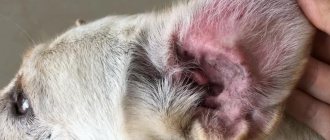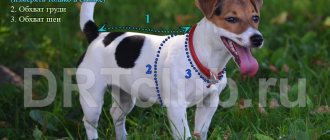Today, almost every second family has a pet, which constantly requires meticulous care. Animals, like people, can exhibit various ailments, and allergies are no exception.
In approximately 20% of cases, itching and redness of the skin in dogs is caused by food allergies. It can last from several months to one year. It is important to understand that allergies and intolerance to any food are not the same thing. When an allergy develops, the animal begins to itch frequently, and also develops various skin-related problems. Intolerance to any product has other symptoms, accompanied by vomiting and loose stools, which has nothing to do with the characteristic manifestations of allergies. It looks more like a digestive system disorder. If a dog is allergic to food, what to do in this case?
How does an allergy manifest itself?
Signs of a food allergy in dogs can vary widely, but most often they are:
- sneezing, coughing, sinus discharge;
- disturbance of the depth and rhythm of breathing, which can lead to the development of asthma;
- loose stools and vomiting. They can appear both together and separately;
- dizziness;
- otitis with damage to the soft tissues of the external meatus and auricle;
- lacrimation, purulent conjunctivitis.
The most common symptoms that accompany food allergies are itching and skin rashes all over the animal's body. If not treated promptly, the rash can lead to the formation of eczema and bleeding ulcers. In some cases, dogs may experience swelling in their limbs, face, digestive tract, and tongue. If left untreated for a long time, food allergies can destroy the immune system, and purulent conjunctivitis can lead to complete blindness.
What is an allergy?
Allergy is “immunity” to external irritants (here food) that are pathogenic for the body. Under normal conditions, the product should become useful, but the immune system rejects it, developing protective mechanisms that lead to the appearance of symptoms. This:
- tearfulness, symptoms of conjunctivitis;
- nasal discharge, frequent sneezing;
- intermittent breathing, asthmatic manifestations;
- loose stools, vomiting;
- otitis of the ear canal.
There are cases when fungal and bacterial diseases are confused with allergies. The symptoms are almost the same.
For example, a doctor compares a dog’s protein allergy to the consumption of low-quality food. And while the animal is on a “diet,” the disease grows to a global scale.
Remember.
You should avoid doctors who, after a quick examination, diagnose you with an allergy. *Carry out high-quality diagnostics for staphylococcus and other protozoa that cause similar symptoms. Make sure the immune system is reacting to the food and not to the bacteria. *Do not feed your dog anti-allergenic drugs until the diagnosis is confirmed. The drugs can seriously harm the dog.
External manifestations of allergies
How does dog allergies manifest externally? In terms of its characteristics, food has a lot in common with regular food. Its main external manifestations are rashes all over the pet’s body. In addition, various ear infections can develop, which over time become chronic. If you start giving your pet antibiotics, these manifestations temporarily disappear, but after a while they return again. Based on external manifestations alone, it is almost impossible to distinguish a food allergy from other possible reactions that may occur in the animal’s body.
Diagnosis of allergies
Identifying food allergies is quite simple, but it is important to understand that many diseases that dogs often suffer from are accompanied by similar symptoms, which, in turn, complicates the diagnosis. Therefore, before starting any treatment, you should try to find out if your pet is suffering from any diseases. For example, if a dog is itching and hair is falling out, it may be caused by scabies, fleas, overly sensitive skin, various intestinal parasites, bacterial infections and thrush.
Causes of food allergies
So, we already know how allergies manifest themselves in dogs, but what are the reasons behind it? As mentioned earlier, this is a response of the immune system to any substance or product that it considers pathogenic.
Most often, allergies are caused by animals eating the following foods:
- any meat;
- milk;
- fish;
- eggs;
- soy;
- wheat;
- corn.
All of these products are found in dog food sold in stores, so allergies are very common. This is due to the fact that plant and animal proteins, regardless of their different origins, have a similar structure. So, if you buy food for a dog with a protein allergy, your pet may get sick.
According to nutritionists, food allergies can be caused not only by intolerance to any ingredients, but also by using the same food over a long period of time.
Treatment of food allergies
The main method of treating food allergies is to eliminate the offending food from the diet. Animals are prescribed a special hypoallergenic diet from which animal proteins are excluded, but first of all, new products are eliminated, after which signs began to appear.
The easiest way is to control the quality of feed prepared at home, as this allows you to exclude the ingress of various preservatives and food additives. Some good sources of protein for dogs include:
- white fish;
- cottage cheese;
- lamb;
- pork;
- idea meat.
It is better to give rice porridge and boiled potatoes as carbohydrate food. Throughout the entire treatment period, you must adhere to strict feeding rules. The diet should be constant; toys and treats should not be used.
If, during the use of dietary feeding, an improvement in health is noted, manifested by a decrease in itching and skin restoration, then this confirms the diagnosis of food allergy. By repeated stimulation (giving a certain food), you can cause another attack in the dog - thus, the harmful food for the pet, which will have to be excluded from the diet, is accurately determined.
Medication for food allergies in dogs is ineffective as a therapeutic measure. But with the help of antiallergic drugs you can stop an attack and reduce the severity of the disease. But it should be understood that the use of these drugs cannot cure a dog of food allergies - the only method of therapy is to adjust feeding.
The use of antihistamines (diazolin, tavegil, suprastin) can reduce the allergic reaction. But their effectiveness in some cases is not so high. Corticosteroids are more effective - prednisolone, methylprednisolone are used once every 2 days, the course can be 1-3 months.
As an emergency, your dog may need intravenous saline solutions. An isotonic solution of sodium chloride, glucose (5-10%), calcium chloride, hemodez are administered intravenously. The drugs are administered slowly, the daily dose can reach 1-2 liters.
Fighting allergies
If a dog is allergic to food, treatment is useless. The only solution to the problem in this case is an elimination diet.
- The first step is to switch the animal to feeding another food that you did not give before.
- Unusual food should be fed for at least three months. It is recommended to choose those types of food containing proteins and carbohydrates that the pet has not previously eaten.
- For example, if the food previously contained beef, you can try feeding dietary foods containing rabbit meat or venison. There are quite a lot of such feeds on sale.
What is the best food to feed a dog if the allergy does not go away over a long period of time? In this case, you can try types of food that use proteins and carbohydrates of such a small molecular size that they simply cannot cause allergies. You can also completely eliminate dry food from the animal’s diet and start giving home-cooked food.
If dogs are allergic to dry food, if you have several pets, then it is recommended to transfer all animals to a new diet. In this case, feeding should be done in separate rooms so that a dog with allergies does not have access to food from healthy individuals.
When eating, the pet should be locked in the next room. This is necessary so that the dog cannot pick up food dropped on the floor, since in this case he will have to start the diet all over again. If you have small children, be sure to wash their hands and face after eating.
Do not let your pet go outside alone, and during walks do not let him off the leash so that he is always under your supervision.
Food allergies in dogs
Symptoms
There are four concepts:
- An adverse food reaction is a clinically abnormal response to food components.
- Hypersensitivity/allergy – increased immune system response to an allergen
- Food intolerance is an abnormal physiological response to food components, the development of pharmacological and metabolic reactions. Not associated with allergies.
- Toxic reactions – dose-dependent response to toxins
The full mechanism of food allergies is not known. Correctly, the reaction occurs to proteins (glycoproteins). Between 35% and 60% of dogs react to more than 1 component. It is more common in animals under 1 year of age. In 15-20% of dogs, along with skin manifestations of allergies, gastrointestinal disorders are observed.
Food allergies
Dog breeds predisposed to food allergies
There is no gender predisposition to food allergies. Can occur at any age. The most commonly affected dog breeds are:
- Labrador
- West Highland White Terrier
- Ridgeback
- Pug
- Boxer
Clinical signs of food allergy:
- Non-seasonal, periodic, recurrent itching
- Otitis in 50-80% of cases
- Affected areas: armpits, groin, abdomen, muzzle, eyelids, perianal area, interdigital space (classic manifestation)
- Recurrent infections
Food allergies
Diagnostics
Unfortunately, there is only one way to diagnose food allergies - a diagnostic diet and provocation. There is not a single test that can confirm or deny a food allergy. The choice of diet is as follows:
- Diagnostic feeds based on new ingredients
- Homemade food made from new ingredients
- Hydrolyzed feeds (contain split proteins, that is, they cannot cause allergies)
It is necessary to use new components for the simple reason that allergies in dogs are cumulative. If you give a dog to eat meat that it has never eaten in its life, then it simply cannot have a reaction to it, since the antibodies could not have time to accumulate. But at the same time, if the clinical picture does not change in the near future (itching continues), it can be argued that the itching is not related to food.
Food allergies
Treatment | Diet for food allergies
When choosing a diet, you should take into account possible cross-reactions - some proteins in different products may have similar properties. So, chicken and turkey can cross-react, as well as beef with venison and lamb. At the same time, it is desirable that the carbohydrates are also new - you also need to change porridge and vegetables in the diet.
The duration of the diet should be 6-8 weeks. By the time of the re-examination there should be no secondary infections or parasites.
Diet failures most often occur due to:
- Non-compliance with the diet (relatives treated them, fed them treats, arbitrarily added vitamins, medicines “in a piece”)
- A large number of animals in the house
- Theft
- Pickiness (refusal of diet food)
Provocation occurs as follows: the animal is returned to its previous diet and the condition is assessed. In most cases, exacerbation of allergies occurs within 7 days, and sometimes even 24 hours. Then the animal is returned to the diet again. Allergies in dogs to a new diet may occur; the development of this reaction is noticeable from 6 to 12 months. A definitive diagnosis of food allergy can only be made after provocation. After provocation, you can try to select foods that are not allergic to once every two weeks, or simply leave the animal on the diet on which the itching initially went away.
Feeding recommendations
A food allergy in dogs, the symptoms of which we already know, never completely goes away, but with the right diet, its manifestations can be completely eliminated. The first thing you should do is stop feeding your pet the usual foods, after which you can start creating a new menu. For example, if your dog's allergic reaction was caused by eating rice, then you should stop giving him anything other than rice. But also any other products that contain this ingredient.
When choosing a new diet, you should try to make it as balanced as possible. It is better to feed with those products that are similar in nutritional value to the previous food. If you do not adhere to this advice, then a lack of any substance can cause exhaustion, which, in turn, will only worsen the situation.
Signs of food allergies
Chicken is a natural source of animal protein, to which some animals and people can develop allergies. But this does not mean that its symptoms will occur when consuming any meat product. For example, lamb or rabbit meat practically does not provoke such a condition.
If the cause of allergic manifestations is the dog eating chicken, then we are talking about a food allergy. Regardless of the source - be it meat, fish or eggs, it has a number of common symptoms:
- the pet is bothered by severe skin itching;
- the skin becomes covered with a rash - most often papules appear in the anus, abdomen, armpits, and on the face;
- discharge appears from the eyes (“so-called souring”), they begin to water;
- discharge from the nose;
- the muzzle may swell;
- wet areas of the skin appear (underarms and in skin folds);
- the dog's skin and fur emit an unpleasant odor;
- damage to the outer ear and auditory canal;
- digestive disorders - diarrhea.
Allergy is a pathological condition with a pronounced individual character. That is, while one dog can consume a product in large quantities, and it will be completely harmless for it, for another, even a piece of food provokes unpleasant manifestations.
According to veterinary practice, there are dog breeds that are most prone to food allergies. This group includes Dachshunds, Labradors, Dalmatians, Shar-Peis, Bulldogs, and German Shepherds. Dogs with white fur often suffer from this pathological condition.
As for allergens, in addition to chicken meat - raw or boiled, pathological manifestations can be caused by the consumption of beef, eggs, soy, semolina, wheat porridge, and fermented milk products. Allergies are often caused by low-quality dry diets or treats that contain artificial additives.
Most often, after eliminating the allergen from the menu, the pet’s allergy symptoms go away. But in some cases, drug treatment is also required, as there is a risk of complications, including anaphylactic shock.
What foods are best to include in your diet?
What is the best food to feed a dog with food allergies?
This question interests many people who have a dog at home. Nutritionists argue that it is not so much the products themselves that are important, but the principle of feeding the animal. It is based on feeding foods that the pet has either never tried before or has not consumed for a long time. When preparing food for your dog, you should only use one type of meat and grain. This feeding method will allow you to determine which substance caused the allergic reaction if you introduce one new ingredient into the diet every two weeks.
What foods should not be given?
If you have a food allergy in dogs, you should avoid feeding your pet certain foods that could be potentially dangerous.
These include:
- sea fish;
- rabbit, turkey and beef;
- today's fermented milk products;
- buckwheat, oat and rice cereals;
- pears, apples, carrots, zucchini.
Feeding with special types of food that have a therapeutic effect is allowed, but they should be selected together with a nutritionist. The specialist will perform a sensitivity test, after which he will be able to select the food that is best suited for your dog. But you should not overuse these foods, since their composition is very poor and they cannot provide the animal with the necessary amount of nutrients. In case of food allergies in dogs, it is very important not only to exclude the allergen from the diet, but also to create a good diet for the animal, which can be fed to the dog on an ongoing basis.
Together with dietary nutrition, the veterinarian can prescribe symptomatic medications that are aimed at reducing histamine levels in the body, relieving inflammatory processes, and also alleviating the clinical manifestations of food allergies in dogs. If the condition is too advanced, a course of immunomodulatory drugs may be necessary. But no medications can ever completely and permanently rid an animal of an allergic reaction without a special diet. At the same time, do not forget that pampering your pet is not the best solution, since even a small piece of a treat containing an allergen can completely negate all your efforts.
Preventing food allergies
To avoid the recurrence of an allergic reaction, you need to follow a number of preventive measures:
exclude allergenic foods from the menu;- avoid walking near the roadway or in industrial areas;
- use repellents that protect the animal from insect bites;
- follow the rules of hair and skin care;
- approach the choice of hygiene products responsibly (give preference to hypoallergenic options);
- Avoid hypothermia or overheating of the animal: as a result, the immune system is significantly weakened.
For how long should a therapeutic diet be followed?
If you have a dog food allergy, it is very important to choose the right diet.
But how long should you stick to it? Doctors advise following a diet for at least three weeks, but, as practice shows, it is not uncommon for an allergic reaction to a product to become apparent after a longer period of time. In most cases, in four-legged friends, an allergy to a new product introduced into the animal’s daily diet appears approximately 12 weeks after the start of feeding. Therefore, you should follow the diet throughout this entire period. If the manifestations of allergies begin to gradually decrease or disappear altogether, then it will be possible to return the pet to a normal feeding regimen using the same products. This is necessary in order to make sure that the animal has an intolerance to any product that provokes the development of allergies.
If a dog's food allergy occurs again, a veterinarian can accurately diagnose the problem and begin treatment. If there is no repeated confirmation of an allergy, but if there is a strong suspicion of it, you can try feeding your pet a different type of food.
Making a diagnosis using laboratory tests
Today in medical practice there is no research method that could establish with one hundred percent probability that a dog has a food allergy.
The most commonly used test is a blood test, but it is ineffective. As for intradermal tests, which are used to diagnose common allergies, in the case of food allergies they do not give any results at all. Therefore, the only way out in this situation is to use the elimination diet, which was described earlier in this article.
"False" allergy
An allergic reaction occurs due to an increase in the level of histamine in the animal’s body. This substance is produced by the immune system in response to the appearance of an allergen in the body. But there are cases when histamine is not produced by the immune system, but enters the body along with some food product. All this leads to the development of a so-called “false” food allergy in dogs, which in its manifestations is very similar to a food allergy.
The whole problem is that the use of special medicinal feeds and changing the diet are ineffective, since not one, but all foods that contain large amounts of histamine and tyramine will have to be removed from the diet. After this, the veterinarian will have to calculate the acceptable level of these substances at which the dog will not develop an allergic reaction. In addition, a special diet will have to be drawn up, consisting of foods containing histamine and tyramine. The purpose of this diet is to accustom the animal’s body to a normal perception of the foods the dog eats. Thus, over time, the dog’s sensitivity to allergenic substances will decrease, and the “false” allergy will disappear.
How are allergies diagnosed in dogs?
The first thing you need to do is identify the allergen. If a specialist suspects a food allergy, he suggests undergoing special sensitivity testing. The owner is offered an expanded formula consisting of 24 items, which he must choose independently. The allergist evaluates the results and finds out what needs to be removed from the pet’s menu and what food is suitable for the dog.
Thanks to the test, all products will be divided into 3 categories:
- must be completely removed from the diet;
- give to dog with caution;
- allowed food.
In addition, differential diagnosis is necessary to distinguish true allergies from false ones. In the second case, symptoms arise from histamine, which is produced by the immune system. But this substance also often enters the body with food, and, as a result, the immune system gives a pseudo-allergic response to the consumption of certain foods. The symptoms for both conditions are almost identical.
In this case, dietary nutrition is unlikely to help, since it is necessary to remove from the diet many foods that contain large amounts of histamine or provoke its production. In case of a “false” allergy, a specific diet is prescribed, which gradually includes similar foods, “accustoming” the body to it.
The list of sources of histamine does not include poultry meat, including chicken; on the contrary, it is recommended to give it to a dog suffering from “pseudo-allergy”.
Recommendations for choosing dog food
If the dog itches and hair falls out, this is the first sign of an allergic reaction. After completing the course of treatment, in order to avoid its reoccurrence, it is necessary to select high-quality food for your pet. It is recommended to adhere to the following tips and recommendations:
- When choosing food, consider your pet's age and activity level. This will help you correctly calculate the nutritional value of the food.
- Consider your pet's nutritional needs. The food must be balanced and contain the optimal amount of proteins and carbohydrates to keep the dog healthy and strong.
- Before purchasing food, consult your veterinarian and ask him which food is best to use for feeding your pet. The specialist will suggest the most optimal option, taking into account the animal’s health condition.
- Never rely on advertising when choosing pet food. Its main goal is to increase sales, not to help consumers choose a quality product.
- Do not use different types of food. Feed your dog either canned or dry food.
By following these tips, you can choose high-quality food for your four-legged friend, from which he will not have any allergies.
If you decide to have a pet at home, remember, this is a big responsibility. He needs some care: regular walks, proper nutrition, as well as attention and care from his owners.











